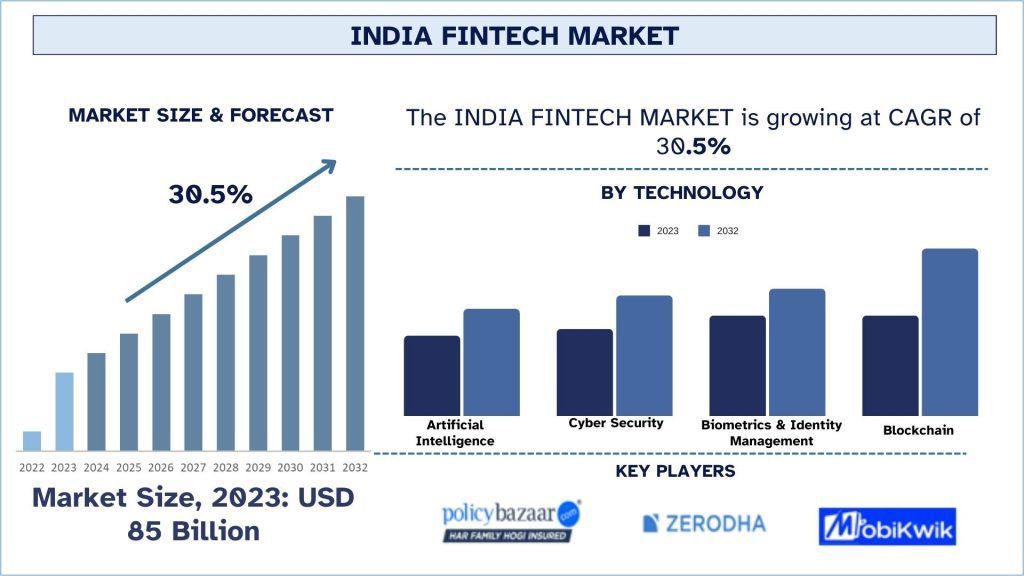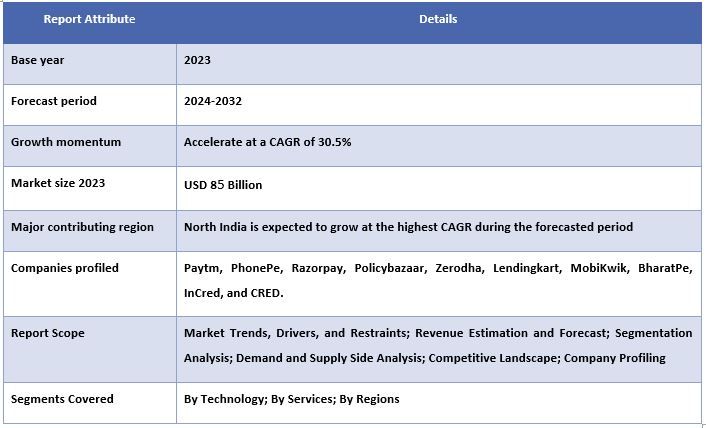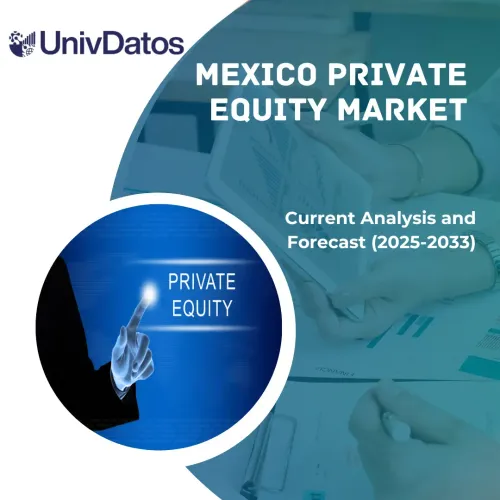- Home
- Chi siamo
- Settore
- Servizi
- Lettura
- Contattaci
Mercato Fintech indiano: Analisi e previsioni attuali (2024-2032)
Enfasi sulla tecnologia (Intelligenza Artificiale, Sicurezza informatica, Biometria e gestione delle identità, Blockchain e altri) e sui servizi (Assicurazioni, Finanza personale, Gestione patrimoniale, Prestiti P2P, Prestiti digitali e mercati dei prestiti, Criptovalute e altri); Regione
Dimensione e previsioni del mercato Fintech indiano
Il mercato Fintech indiano è stato valutato a 85 miliardi di USD nel 2023 e si prevede che crescerà a un robusto CAGR di circa il 30,5% durante il periodo di previsione (2024-2032).
Analisi del mercato Fintech indiano
- Un Fintech è una struttura fisica centralizzata in cui le organizzazioni archiviano, gestiscono e distribuiscono i propri dati, applicazioni e infrastrutture IT. In genere ospita numerosi server, sistemi di archiviazione, apparecchiature di rete e altri componenti necessari per la gestione e l'elaborazione di grandi quantità di dati. I Fintech garantiscono elevata disponibilità, scalabilità, sicurezza e funzionamento efficiente dei sistemi IT. Sono utilizzati da varie entità, tra cui aziende, istituzioni educative, agenzie governative e fornitori di servizi cloud, per supportare le proprie esigenze di elaborazione e archiviare risorse digitali critiche.
- L'India ha investito pesantemente nella costruzione di Fintech all'avanguardia per soddisfare la crescente domanda di vari settori, tra cui finanza, telecomunicazioni, sanità e settori governativi. Il mercato Fintech indiano offre molteplici servizi, tra cui colocation, hosting, cloud, disaster recovery e servizi gestiti. Con il crescente volume di dati generati da aziende e individui, i Fintech sono fondamentali per garantire la disponibilità, la sicurezza e la scalabilità delle infrastrutture digitali. I principali fattori trainanti per il mercato Fintech indiano includono la crescente adozione di iniziative di trasformazione digitale, le politiche governative che promuovono gli investimenti nel settore ICT e la crescente domanda di archiviazione e gestione dei dati da parte di e-commerce, banche e sanità.
Segmentazione del mercato Fintech indiano
- In base alla tecnologia, il mercato Fintech indiano è segmentato in Intelligenza Artificiale, Sicurezza informatica, Biometria e gestione delle identità, Blockchain e altri. Il segmento Intelligenza Artificiale ha guidato il mercato nel 2023 con la quota di mercato più alta. Le tecnologie di intelligenza artificiale consentono alle aziende fintech di personalizzare i servizi, raccomandare prodotti e offrire assistenza clienti tramite chatbot e assistenti virtuali. Ciò migliora il coinvolgimento e la soddisfazione degli utenti, aumentando la fidelizzazione e la fedeltà dei clienti. Inoltre, l'IA facilita lo sviluppo di prodotti e servizi finanziari innovativi, come i robo-advisor per la gestione patrimoniale, le piattaforme di investimento automatizzate e i sistemi di trading algoritmico. Queste offerte si rivolgono a consumatori esperti di tecnologia che cercano soluzioni finanziarie senza soluzione di continuità e basate sui dati.
- Il mercato Fintech indiano è segmentato per servizi in BFSI, sanità, telecomunicazioni e IT, governo e altri. Assicurazioni, Finanza personale, Gestione patrimoniale, Prestiti P2P, Prestiti digitali e mercati dei prestiti, Criptovalute e altri. Il segmento Prestiti digitali e mercati dei prestiti ha guidato il mercato nel 2023 con la quota di mercato più alta. Le piattaforme di prestito digitale hanno colmato un vuoto critico nel panorama finanziario indiano, fornendo soluzioni di credito accessibili ed efficienti a privati e piccole imprese. Questo segmento è cresciuto notevolmente a causa dell'elevata domanda di prestiti rapidi e senza problemi. Inoltre, sfruttando tecnologie avanzate come l'intelligenza artificiale (IA), l'apprendimento automatico (ML) e l'analisi dei dati, le piattaforme di prestito digitale semplificano il processo di richiesta di prestito, valutano l'affidabilità creditizia in tempo reale e automatizzano il processo decisionale. Ciò migliora l'efficienza operativa e riduce i tempi di risposta per i mutuatari.
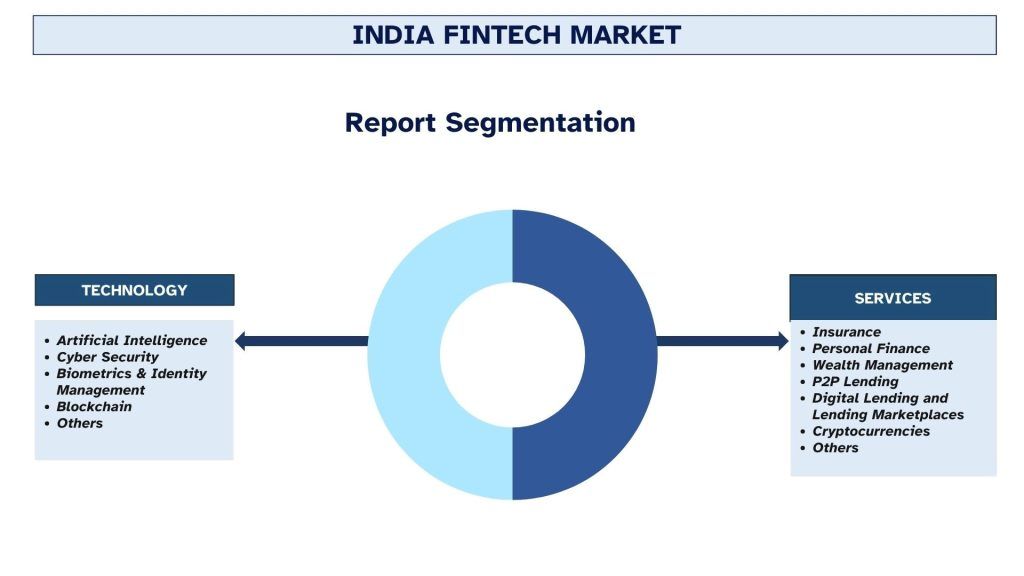
L'India settentrionale ha detenuto una quota dominante del mercato nel 2023
L'India settentrionale ha guidato il mercato nel 2023. L'India settentrionale ha visto progressi significativi nell'infrastruttura digitale e nella connettività Internet, in particolare nei centri urbani come Delhi e Noida e nelle città in rapido sviluppo di livello 2 e livello 3. La proliferazione di smartphone e piani dati convenienti ha democratizzato l'accesso ai servizi finanziari digitali tra una popolazione eterogenea. Esempio: Transazioni UPI: l'Unified Payments Interface (UPI) ha ottenuto un'immensa popolarità nell'India settentrionale. Facilita trasferimenti peer-to-peer, pagamenti di bollette e transazioni commerciali senza soluzione di continuità. La regione contribuisce in modo sostanziale ai volumi complessivi delle transazioni UPI del paese, sottolineando la sua rapida adozione di soluzioni di pagamento digitale.
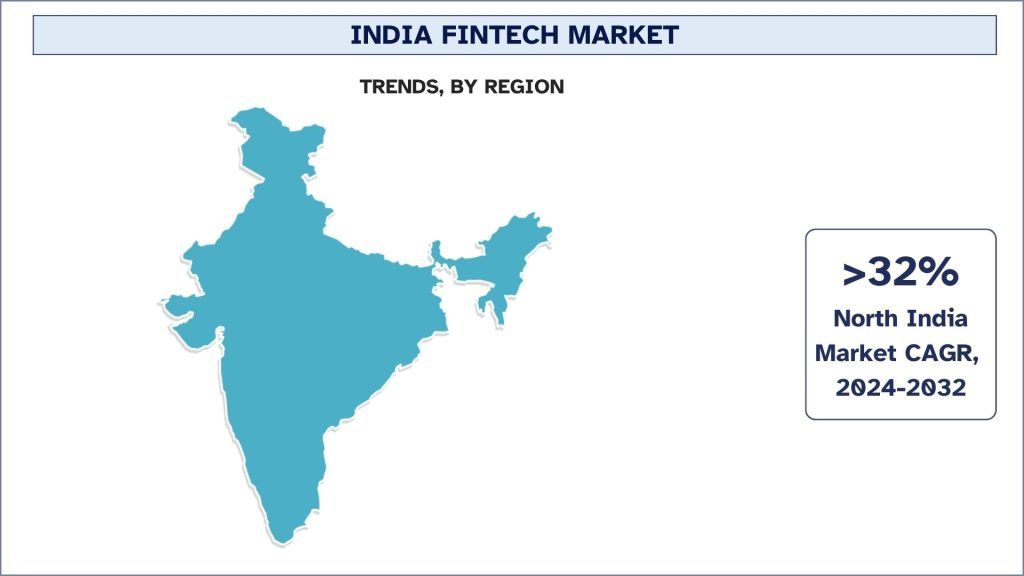
Panoramica del settore Fintech indiano
Il mercato Fintech indiano è competitivo e frammentato, con diversi attori regionali e internazionali. I principali attori stanno adottando diverse strategie di crescita per migliorare la propria presenza sul mercato, come partnership, accordi, collaborazioni, lanci di nuovi prodotti, espansioni geografiche e fusioni e acquisizioni. Alcuni dei principali attori operanti nel mercato includono Paytm, PhonePe, Razorpay, Policybazaar, Zerodha, Lendingkart, MobiKwik, BharatPe, InCred e CRED.
Notizie sul mercato Fintech indiano
- Nel 2023, PhonePe ha acquisito Indus OS, un sistema operativo mobile sviluppato internamente che integra funzionalità UPI e pagamenti digitali. Questa acquisizione mira a migliorare l'interfaccia utente di PhonePe e ad espandere il suo ecosistema di pagamenti digitali.
- Nel 2022, Google Pay ha lanciato Google Pay for Business in India, una piattaforma di pagamenti digitali per piccole e medie imprese (PMI). Questa piattaforma ha fornito alle aziende strumenti per pagamenti digitali, generazione di fatture e coinvolgimento dei clienti, migliorando la loro efficienza operativa e la gestione finanziaria.
Copertura del rapporto sul mercato Fintech indiano
Motivi per acquistare questo rapporto:
- Lo studio include analisi di dimensionamento e previsioni del mercato validate da esperti chiave del settore autenticati.
- Il rapporto presenta una rapida panoramica delle prestazioni complessive del settore a colpo d'occhio.
- Il rapporto copre un'analisi approfondita dei principali attori del settore, con particolare attenzione alle principali informazioni finanziarie aziendali, ai portafogli di prodotti, alle strategie di espansione e agli sviluppi recenti.
- Esame dettagliato dei fattori trainanti, dei vincoli, delle tendenze chiave e delle opportunità prevalenti nel settore.
- Lo studio copre in modo completo il mercato in diversi segmenti.
- Analisi approfondita a livello regionale del settore.
Opzioni di personalizzazione:
Il mercato Fintech indiano può essere ulteriormente personalizzato in base alle esigenze o a qualsiasi altro segmento di mercato. Inoltre, UMI comprende che potresti avere le tue esigenze aziendali, quindi non esitare a connetterti con noi per ottenere un rapporto che si adatti completamente alle tue esigenze.
Indice
Metodologia di ricerca per l'analisi del mercato globale della trombosi venosa profonda (2024-2032)
L'analisi del mercato storico, la stima del mercato attuale e la previsione del mercato futuro del mercato globale della trombosi venosa profonda sono stati i tre passaggi principali intrapresi per creare e analizzare l'adozione della trombosi venosa profonda globale nelle principali regioni. È stata condotta un'ampia ricerca secondaria per raccogliere i numeri storici del mercato e stimare le dimensioni attuali del mercato. In secondo luogo, per convalidare queste intuizioni, sono state prese in considerazione numerose scoperte e ipotesi. Inoltre, sono state condotte anche ampie interviste primarie, con esperti del settore in tutta la catena del valore del mercato globale della trombosi venosa profonda. Dopo l'assunzione e la convalida dei numeri di mercato tramite interviste primarie, abbiamo impiegato un approccio top-down/bottom-up per prevedere le dimensioni complete del mercato. Successivamente, sono stati adottati metodi di scomposizione del mercato e di triangolazione dei dati per stimare e analizzare le dimensioni del mercato dei segmenti e dei sottosegmenti del settore pertinenti. La metodologia dettagliata è spiegata di seguito:
Analisi delle dimensioni storiche del mercato
Fase 1: Studio approfondito delle fonti secondarie:
È stato condotto uno studio secondario dettagliato per ottenere le dimensioni storiche del mercato globale della trombosi venosa profonda attraverso fonti interne aziendali come relazioni annuali e rendiconti finanziari, presentazioni delle prestazioni, comunicati stampa, ecc. e fonti esterne tra cui riviste, notizie e articoli, pubblicazioni governative, pubblicazioni dei concorrenti, rapporti di settore, database di terze parti e altre pubblicazioni credibili.
Fase 2: Segmentazione del mercato:
Dopo aver ottenuto le dimensioni storiche del mercato globale della trombosi venosa profonda, abbiamo condotto un'analisi secondaria dettagliata per raccogliere informazioni e quote storiche del mercato per diversi segmenti e sottosegmenti per le principali regioni. I principali segmenti sono inclusi nel rapporto come classe di farmaci, trattamento, utente finale e regioni. Ulteriori analisi a livello di paese sono state condotte per valutare l'adozione complessiva dei modelli di test in quella regione.
Fase 3: Analisi dei fattori:
Dopo aver acquisito le dimensioni storiche del mercato dei diversi segmenti e sottosegmenti, abbiamo condotto un dettagliatoanalisi dei fattoriper stimare le dimensioni attuali del mercato globale della trombosi venosa profonda. Inoltre, abbiamo condotto l'analisi dei fattori utilizzando variabili dipendenti e indipendenti come la classe di farmaci, il trattamento, l'utente finale e le regioni del mercato globale della trombosi venosa profonda. È stata condotta un'analisi approfondita degli scenari di domanda e offerta, considerando le principali partnership, fusioni e acquisizioni, l'espansione del business e i lanci di prodotti nel settore del mercato globale della trombosi venosa profonda in tutto il mondo.
Stima e previsione delle dimensioni attuali del mercato
Dimensionamento del mercato attuale:Sulla base di approfondimenti attuabili dai 3 passaggi precedenti, siamo giunti alle dimensioni attuali del mercato, ai principali attori nel mercato globale della trombosi venosa profonda e alle quote di mercato dei segmenti. Tutte le suddivisioni delle quote percentuali richieste e le scomposizioni del mercato sono state determinate utilizzando l'approccio secondario sopra menzionato e sono state verificate tramite interviste primarie.
Stima e previsioni:Per la stima e la previsione del mercato, sono stati assegnati dei pesi a diversi fattori, tra cui fattori trainanti e tendenze, vincoli e opportunità disponibili per gli stakeholder. Dopo aver analizzato questi fattori, sono state applicate tecniche di previsione pertinenti, ovvero l'approccio top-down/bottom-up, per arrivare alle previsioni di mercato per il 2032 per i diversi segmenti e sottosegmenti nei principali mercati a livello globale. La metodologia di ricerca adottata per stimare le dimensioni del mercato comprende:
- Le dimensioni del mercato del settore, in termini di ricavi (USD) e il tasso di adozione del mercato globale della trombosi venosa profonda nei principali mercati a livello nazionale
- Tutte le quote percentuali, le divisioni e le ripartizioni dei segmenti e dei sottosegmenti di mercato
- I principali attori nel mercato globale della trombosi venosa profonda in termini di tipi offerti. Inoltre, le strategie di crescita adottate da questi attori per competere nel
mercato in rapida crescita.Convalida delle dimensioni e della quota di mercato
Ricerca primaria:Sono state condotte interviste approfondite con i Key Opinion Leader (KOL) tra cui Top Level Executives (CXO/VP, Sales Head, Marketing Head, Operational Head, Regional Head, Country Head, ecc.) in tutte le principali regioni. I risultati della ricerca primaria sono stati poi riassunti e sono state eseguite analisi statistiche per dimostrare l'ipotesi dichiarata. Gli input dalla ricerca primaria sono stati consolidati con i risultati secondari, trasformando così le informazioni in approfondimenti utili.
Suddivisione dei partecipanti primari in diverse regioni
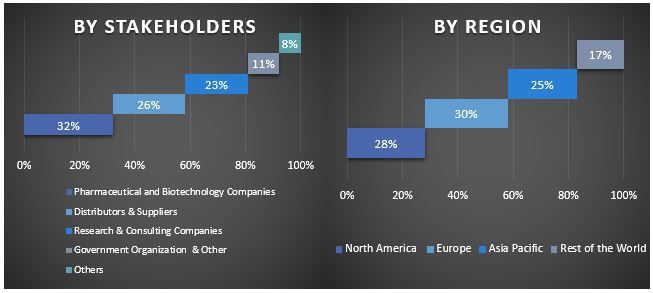
Ingegneria del mercato
La tecnica di triangolazione dei dati è stata impiegata per completare la stima complessiva del mercato e per arrivare a numeri statistici precisi per ogni segmento e sotto-segmento del mercato globale della trombosi venosa profonda. I dati sono stati suddivisi in diversi segmenti e sotto-segmenti dopo aver studiato vari parametri e tendenze nella classe di farmaci, trattamento, utente finale e regioni nel mercato globale della trombosi venosa profonda.
L'obiettivo principale dello studio sul mercato globale della trombosi venosa profonda
Le attuali e future tendenze del mercato globale della trombosi venosa profonda sono state individuate nello studio. Gli investitori possono ottenere informazioni strategiche per basare le loro decisioni di investimento sull'analisi qualitativa e quantitativa eseguita nello studio. Le attuali e future tendenze del mercato hanno determinato l'attrattiva complessiva del mercato a livello regionale, fornendo una piattaforma per il partecipante industriale per sfruttare il mercato inesplorato per beneficiare di un vantaggio del first-mover. Altri obiettivi quantitativi degli studi includono:
- Analizzare le dimensioni attuali e previste del mercato globale della trombosi venosa profonda in termini di valore (USD). Inoltre, analizzare le dimensioni attuali e previste del mercato di diversi segmenti e sotto-segmenti.
- I segmenti nello studio includono aree della classe di farmaci, trattamento, utente finale e regioni.
- Definire e analizzare il quadro normativo per il settore.
- Analizzare la catena del valore coinvolta con la presenza di vari intermediari, insieme all'analisi dei comportamenti dei clienti e dei concorrenti del settore.
- Analizzare le dimensioni attuali e previste del mercato globale della trombosi venosa profonda per le principali regioni.
- I principali paesi delle regioni studiate nel rapporto includono Asia Pacifico, Europa, Nord America e Resto del mondo
- Profili aziendali del mercato globale della trombosi venosa profonda e le strategie di crescita che gli attori adottano per sostenersi nel mercato in rapida crescita.
- Analisi approfondita del settore a livello regionale
Domande frequenti FAQ
Q1: Qual è l'attuale dimensione del mercato e il potenziale di crescita del mercato Fintech indiano?
Q2: Quali sono i fattori trainanti per la crescita del mercato Fintech indiano?
Q3: Quale segmento detiene la maggiore quota di mercato Fintech indiano per tecnologia?
Q4: Quali sono le tecnologie e le tendenze emergenti nel mercato Fintech indiano?
Q5: Quale regione dominerà il mercato Fintech indiano?
Correlati Report
I clienti che hanno acquistato questo articolo hanno acquistato anche

